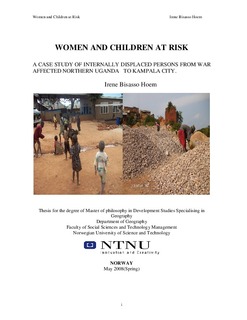| dc.contributor.author | Hoem, Irene Bisasso | nb_NO |
| dc.date.accessioned | 2014-12-19T14:25:44Z | |
| dc.date.available | 2014-12-19T14:25:44Z | |
| dc.date.created | 2009-02-17 | nb_NO |
| dc.date.issued | 2008 | nb_NO |
| dc.identifier | 173702 | nb_NO |
| dc.identifier.uri | http://hdl.handle.net/11250/265290 | |
| dc.description.abstract | OHCHR (2007) reports that at the international level, no single agency or organization has been designated as the global lead on protection and assistance of internally displaced persons. The case of women and children urban IDPs from war affected northern Uganda to Kampala poses salient questions on the state of their basic human needs, survival strategies and the perception, which all reflects urban IDPs’ rights.
A qualitative approach was used, involving direct observation, interviews (in depth and focused group discussions) and visual materials (photographs and children’s drawings) to gather primary data. Secondary data from various published and unpublished sources were used and acknowledged. The findings to the above questions reveal that women and children identify almost similar basic human needs. Nevertheless, each category has special additional needs depending on age, gender and responsibilities. Most of their basic needs are unmet and the state of such needs show how their basic human rights as per the CRC, CEDAW and the 1995 constitution of Uganda are not uplifted. Women and children are participating in many social and economic activities, despite the fact that survival continues to be a daily struggle and places many women and children at risks. Fortunately some strategies are not only providing survival but empowerment and participation as well.
Urban IDPs and host community have diverse perceptions about each other. The host community is reported to be crucial in determining how urban IDPs survive and access basic human needs. The author concludes that women and children IDPs are unable to claim their rights and are at risk. Recommendations are suggested concerning the provision and access to basic human needs, enhancement of participation and empowerment of women and children urban IDPs, so that they get in position to claim their rights. Finally further research ideas are identified. | nb_NO |
| dc.language | eng | nb_NO |
| dc.publisher | Norges teknisk-naturvitenskapelige universitet, Fakultet for samfunnsvitenskap og teknologiledelse, Geografisk institutt | nb_NO |
| dc.title | WOMEN AND CHILDREN AT RISK: A CASE STUDY OF INTERNALLY DISPLACED PERSONS FROM WARAFFECTED NORTHERN UGANDA TO KAMPALA CITY. | nb_NO |
| dc.type | Master thesis | nb_NO |
| dc.contributor.department | Norges teknisk-naturvitenskapelige universitet, Fakultet for samfunnsvitenskap og teknologiledelse, Geografisk institutt | nb_NO |
